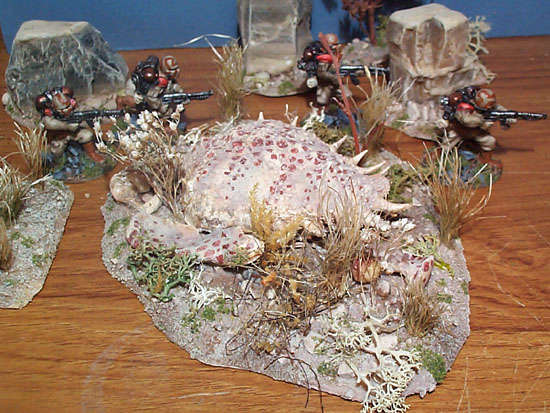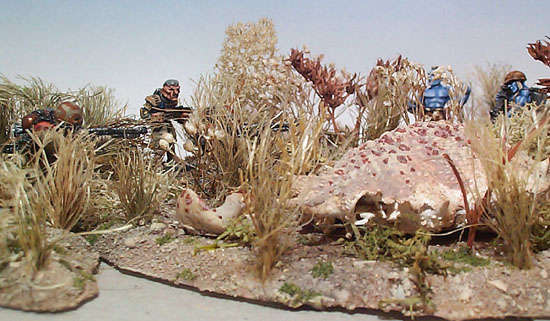|
|
©1999-2003. All rights reserved. |
Crab Skeleton
If you are making scenery for a sci-fi game then crab skeletons
and the hard shelled remains of other sea-life can be a cheap and easy
way to spice up the terrain. I particularly to combine them with the
arid terrain, evoking an image of long-gone seas, perhaps banished by
terraforming, where these giant and exotic creatures once roamed.
Materials
| ||
 The models here are from Alternative Armies.
In the background are Rock
Pillars.
The models here are from Alternative Armies.
In the background are Rock
Pillars. |
Painting

The crab skeleton was practically this colour already, but it was painted to accentuate the texture.
![]() 1)
Reddish brown wash - First it was given a light reddish brown
wash. There was no base coat - the natural colour was allowed to come
through to some extent.
1)
Reddish brown wash - First it was given a light reddish brown
wash. There was no base coat - the natural colour was allowed to come
through to some extent.
![]() 2)
Light brown drybrush - (fairly wet)
2)
Light brown drybrush - (fairly wet)
![]() 3)
Dark Spots - Note the spots are different sizes to create a more
random, organic look. One effect of these is to emphasise that the
various fragments are part of one animal.
3)
Dark Spots - Note the spots are different sizes to create a more
random, organic look. One effect of these is to emphasise that the
various fragments are part of one animal.
![]() 4)
Final Drybrush - After the spots had been painted on, a delicate
drybrush of 'Beige' Sandtex was applied over the top of the whole
shell. This made the spots look less stark as well as providing final
highlights for the main shell.
4)
Final Drybrush - After the spots had been painted on, a delicate
drybrush of 'Beige' Sandtex was applied over the top of the whole
shell. This made the spots look less stark as well as providing final
highlights for the main shell.


